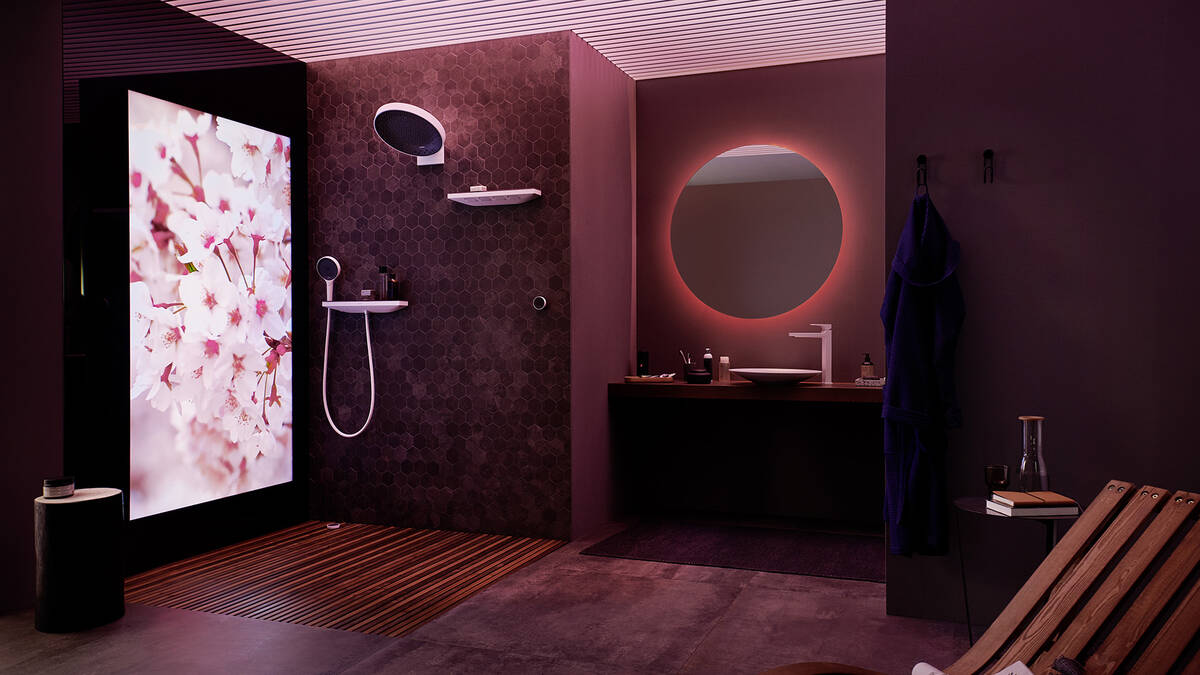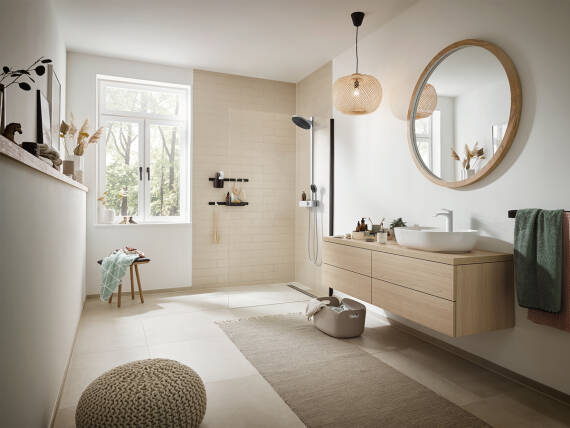What trends to expect in 2023
Bathroom trends in 2023: A room re-imagined
Are you already planning your design projects for 2023, and have your bathroom in mind? Then get to know the current trends for the bathroom as well as new material and design ideas here. This much we can already reveal: It’s going to be cozy!

Design trends: These colors and materials have good prospects

The trend towards an oasis of wellbeing will stay strong in the coming year. The bathroom is no longer a purely functional space, it’s becoming a place with a high sojourn quality: this is where we can wind down after a long day, listen to our favorite music while enjoying a warm shower, and while the kids are splashing around in the bath tub, we can leaf through a magazine while sitting in an armchair.
This kind of cozy atmosphere is also enhanced by the trends for the next year:
- Strong colors as a contrast: The faucet in warm metallic tones or the colored sink are eye-catchers in the simple, natural bathrooms of the scandi style.
- Black for the bold: The reverse of the classic, practical ceramics in white are black ceramics, faucets, and furniture, which give the room a very elegant touch. Playful black and white contrasts are also available.
- Matte surfaces: While glossy tiles and ceramics look rather ordinary, a matte surface immediately gives them an especially upscale touch.
- Seamless shower: An interesting alternative to conventional tiles are decorative backsplashes in the shower or at the sink, giving the room a homey character. You can choose from a wide variety decor panels in different colors and looks.
- Beautiful wallpapers: One continuing trend are wallpapers with sensational panoramas, playful floral motifs, and minimalist graphics.
- New closeness to nature: Finally, real wood and wood-look surfaces are finding their way into this space. Techniques and materials for waterproofing make it possible. The renewable raw material is finding its place in interior design as tiles, real wood flooring, or as sinks.
- Large-area marble tiles: The large surfaces of the tiles for walls and floors, up to three meters long, create calm and exude elegance and taste without being too prominent.
Theme trends: Sustainable design and smart technology
Bathroom trends in 2023 not only touch on design aspects, but also on topics like sustainability and smart home:
- Sustainability: Furniture and materials are increasingly being selected based on sustainable aspects like manufacturing and processing. Moreover, buyers are opting for high-quality products that have a long service life, and thus save resources.
- Saving energy: Saving water saves money. That’s why economical shower systems, power-saving LED lights, and smart radiator thermostats are popular gadgets.
- Smart home control: Light, heating, and sound systems can be conveniently controlled via smartphone, even while relaxing in the bath tub.
- Wellness moments in the shower: For an all-around relaxing shower experience, use shower systems like hansgrohe Raintunes. You tell the hansgrohe Home app what you want, and it creates an intoxicating atmosphere of light and music to match your mood.
- Hygienic comfort: Rimless shower toilets with integrated hairdryer facilitate pleasant, hygienic cleaning.
These are the trends: 2023 is going to relax comfortably and sustainably
There’s still room for improvement: If you know next year’s trends, you can target them. They show that bathrooms can be more than functional spaces. With loving details and high-quality materials, it is a place in your home that invites you to feel good and relax. By choosing high-quality and durable products, everyone can also make their contribution to a more sustainable home and life – and the mindful use of resources is right on trend.
Frequently asked questions about trends in 2023
The room isn’t limited to its functions, and instead is understood as a place for rest and relaxation. That is why it’s being designed to be increasingly homey and needs-oriented.
Strong colors and metallic tones are popular accents, as are all-black designs. Matte surfaces provide an elegant touch.
Furniture, floors, and walls in wood, large marble tiles, and wallpaper with floral and graphic patterns are very popular.
Technical gadgets are being used more and more to save energy. These include economical shower systems, LED lights, and smart radiator thermostats that regulate heat supply. Sustainable trends also include the use of wood as a renewable raw material.
The smart home is in vogue: all you need is an app to control lighting, music, and heating directly from the bath tub.
Trusted partners